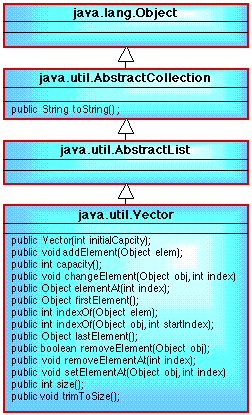1. OVERVIEW
From the work on arrays we have seen that we usual declare the size of the array prior to run time. Using the dynamic array concept we can of course delay this declaration till run time, but the size of the array is always fixed once it has been declared. An alternative data structure, known as a vector, will allow for data items to be stored in an array like structure but without having to declare its length. On declaring a vector we specify an initial size which is automatically doubled whenever we run out of space.
The Java API includes a class vector contained in the java.util package (Figure 1).
The idea behind vectors is similar to the concept of flexible arrays found in some early imperative languages (for exsample Algol'68), although it is not found in more recent imperative languages such as Ada or C. Flexible arrays are essentially arrays that can be "resized" during runtime, thus not quite the same thing asd vectors which have both a capcity and a size (more on this in the following section).

Figure 1: Vector class diagram.